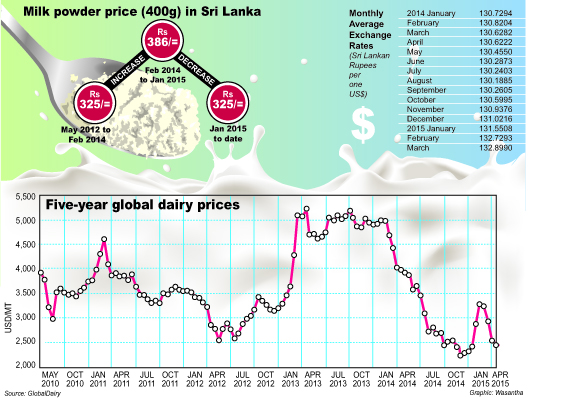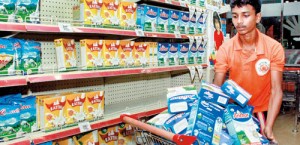News
Cry over powdered milk as prices plunge in world market
The price of whole milk powder in the global market plunged by 43 per cent last year, but on Sri Lankan shelves the essential commodity was sold for a fixed price throughout the decline.
Prices on Fonterra’s GlobalDairy Trade auction started dropping in February 2014 and slid steadily for ten months. In December, they reached five-year lows—or a reduction of roughly 43 per cent, compared with the heights they had risen to in early February.
While prices rallied briefly in January and February of this year, they started declining again at the beginning of March. They are now close to the rock-bottom levels they were in December. In Sri Lanka, however, consumers paid a static Rs. 386 per 400 grams of whole milk powder throughout this period.
It was only in January 2015 that the new government, under pressure to deliver on promises made during Maithripala Sirisena’s presidential campaign, slashed the tax on whole milk powder by Rs. 61. This brought the price down to Rs. 325 per 400g. There was no revision based on the international market.
The collapse in global milk powder prices is not passed onto local consumers due to the Government’s controlled prices and taxes, analysts critiqued. Tariffs are left high, ostensibly to promote local milk production.
“Initiatives to promote liquid milk are commendable, but much more needs to be done in terms of output and distribution,” one analyst said, requesting anonymity. “Without the widespread use of fridges, excellent distribution is needed. But does Sri Lanka produce enough fresh milk to begin with?”
To make things worse — and, possibly, only in Sri Lanka — milk powder is heavily politicised. Governments believe that volatility in prices will swing public opinion against them and Oppositions have airily exploited this fear. No election campaign is complete without a tear-jerking advertisement on the high price of milk powder.

The collapse in global milk powder prices is not passed onto local consumers due to the Government’s controlled prices and taxes, analysts critiqued. (File pic)
This has led to a vicious cycle of price-regulation that is wildly disproportionate to the highs and lows of the international market. “The prices are controlled by the Government in order to prevent excessive volatility affecting consumers,” said Deshal de Mel, economist.
“When prices increase significantly, the companies have to take a hit,” he explained. “On the flip side, when prices are dropping, you need to compensate the companies by allowing them to make some profit which, at such a time, would be at the expense of the consumer.”
There must be a transparent pricing formula, Mr. de Mel insisted. Only then can it be understood why local prices have not come down. “Without transparency, it is not possible even to comment on who is benefiting excessively or otherwise,” he noted. “This applies to everything, be it fuel, cement or milk powder.”
An analysis of global market prices over a five-year period shows that milk powder distributors have taken some heavy blows. The last price increase permitted by the Government was in February 2014, shortly before the global market started tumbling. It was preceded by a three-month battle with distributors who instigated a severe shortage of milk powder in Sri Lanka’s wholesale and retail markets.
The only revision before that was in May 2012, a full twenty months prior. But prices fluctuated widely during that period, reaching sharp highs between March 2013 and mid-February 2014. The local market remained heavily regulated throughout.
Sources from the Consumer Affairs Authority (CAA) said, however, that when global prices rose significantly, milk food companies varied the blend of their product to continue to stay in business. “There are different qualities within the world market,” said an official, who did not wish to be named. “There are also different prices.”
“The companies have blending plants in Sri Lanka,” he elaborated. “They typically purchase one quality at a higher rate, others at lower rates and blend them here for the local market. This is one reason we cannot depend on world market prices.”
“There are times when companies sacrifice their profit to keep prices stable here,” the official admitted. “This is something we have to consider.” But is not known what these profit margins are or how they are adjusted. That remains confidential company data.
A reasonable, transparent pricing formula is doubly important because imported milk powder remains overwhelmingly popular in Sri Lanka. This is despite a dual Government policy to encourage self-sufficiency in milk and a switch from imported milk powder to locally produced liquid milk. Fonterra says on its Asia website that Sri Lankans consume 1.3 billion glasses of milk every year.
Some analysts also question the choice of successive regimes to impose heavy taxes on an essential commodity—one that is vital to the health and well-being of citizens—such as milk. “I can understand them doing this for luxury items but why milk?” one asked. “And why is cheese so expensive in Sri Lanka? These are questions we must ask of our Governments.”
Given how wide the consumption of milk powder is in Sri Lanka, the State has gathered some hefty revenues over the years. And with its “policy” of promoting local production constantly in disarray, its coffers will continue to get richer thanks to the white powder from foreign shores.
| What Fonterra had to sayFonterra, New Zealand’s multinational dairy co-operative, is the leading distributor of milk products in Sri Lanka. The company did not answer a specific query about their market share but published figures point to around 60 per cent. The Sunday Times sent a list of questions to Fonterra via its public relations agency. In a generic reply, Leon Clement, Managing Director of Fonterra Brands in Sri Lanka, said the maximum retail price of full cream milk powder is set by the Government. “It is important to understand that it is not determined solely by global dairy prices,” Mr Clement pointed out. Among the other contributory factors he cited were raw material costs, transport, taxes, duties, packaging, currency depreciation, labour, fuel and local wholesale and retail margins. Global daily prices, and these other input costs, are volatile, he continued: “Prices are not adjusted with every moment to maintain a more stable retail price and protect consumers. To put this into context, the retail milk price in Sri Lanka has moved less than 20 per cent in either direction in the last 18 months despite global milk prices rising by over 100 per cent and falling by 50 per cent over the same period.” But the Sunday Times found that some of the input costs referred to in Mr Clement’s statement were also regulated by the Government. For instance, the import tax is fixed at Rs. 135 per kilogram; the Port and Airport Development Levy (PAL) is at 5 per cent on Cost, Insurance and Freight (CIF) value; and the rule for clearing and handling charges is 1 per cent of CIF value or Rs. 4 per kilogram, whichever is lower. Packing costs, overhead costs and manufacturer’s profit, are similarly controlled. Meanwhile, the exchange rate remained stable in 2014 when the steepest global price declines were recorded. There are certain components, however, that the CAA cannot control. This includes the contract price between the parent and subsidiary company. |

